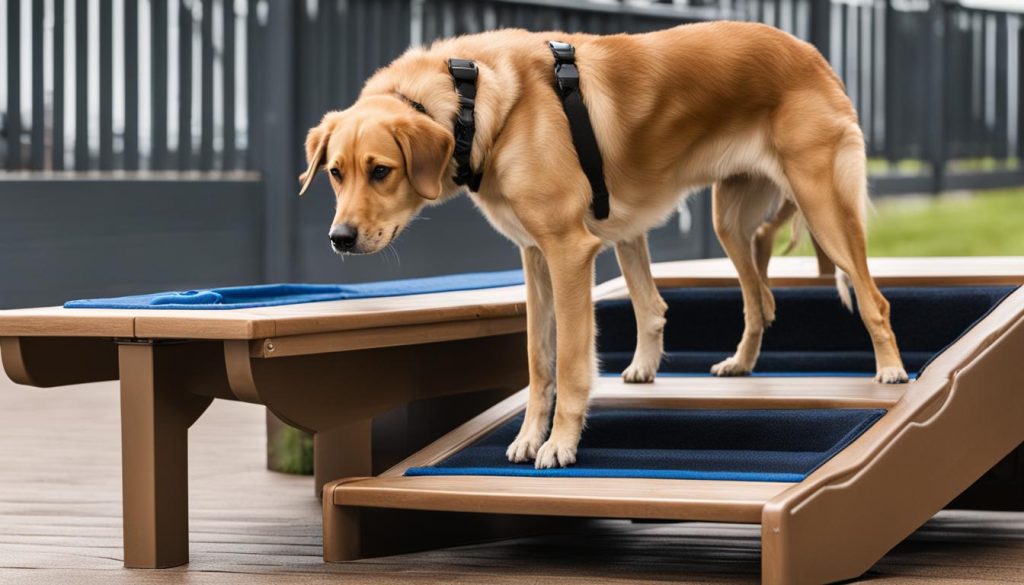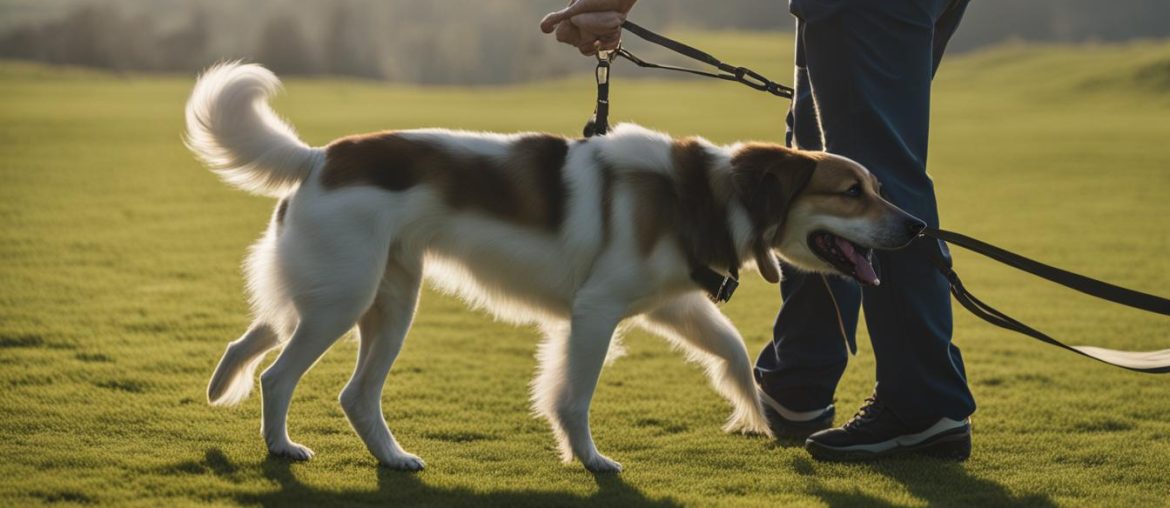As dogs age, their hind legs can weaken, leading to mobility issues and discomfort. There are several factors that can contribute to this, including arthritis, hip dysplasia, muscle atrophy, degenerative myelopathy, and intervertebral disc disease. It’s important to identify the underlying cause of your dog’s hind leg weakness and seek veterinary attention. In this article, we will explore the signs and symptoms of hind leg deterioration, as well as provide tips and exercises to help strengthen your older dog’s hind legs.
Key Takeaways:
- Older dogs can develop hind leg weakness due to various factors such as arthritis, hip dysplasia, and muscle atrophy.
- Signs of hind leg deterioration include trembling hind legs, difficulty standing, walking difficulties, and muscle mass loss.
- Exercises like passive range of motion, sit/stand transitions, regular walks, and swimming can strengthen older dogs’ hind legs.
- Providing a nutritious diet and incorporating joint supplements can support hind leg strength.
- Alternative treatments like acupuncture and mobility aids such as wheelchairs and lifting harnesses can improve mobility in older dogs.
Common Causes of Hind Leg Weakness in Older Dogs

Hind leg weakness in older dogs can be attributed to several common causes, including arthritis, hip dysplasia, muscle atrophy, degenerative myelopathy, and intervertebral disc disease. These conditions can lead to mobility issues and discomfort, making it essential to identify the underlying cause to ensure proper treatment and management.
Arthritis is a prevalent cause of hind leg weakness in older dogs, as it causes the deterioration of cartilage and triggers inflammation in the joints. Hip dysplasia, characterized by a loose hip joint, can also contribute to weak hind legs. Muscle atrophy, which is the loss of muscle mass due to lack of activity, and degenerative myelopathy, a genetic neurological disease, are additional factors that can result in hind leg weakness. Furthermore, intervertebral disc disease, which involves slipped discs, can cause sudden mobility loss and weakness in the hind limbs.
Identifying the specific cause of hind leg weakness in your older dog is crucial for implementing appropriate treatment strategies and management plans. A comprehensive understanding of the common causes enables targeted interventions that can help improve your dog’s mobility and overall quality of life.
Table: Common Causes of Hind Leg Weakness in Older Dogs
| Causes | Description |
|---|---|
| Arthritis | Deterioration of cartilage and inflammation in the joints |
| Hip Dysplasia | Loose hip joint |
| Muscle Atrophy | Loss of muscle mass due to lack of activity |
| Degenerative Myelopathy | Genetic neurological disease |
| Intervertebral Disc Disease | Slipped discs causing mobility loss |
Signs and Symptoms of Hind Leg Deterioration

Recognizing the signs and symptoms of hind leg deterioration in older dogs is essential for early intervention and proper treatment. Here are some key indicators to watch out for:
- Trembling or shaking of the hind legs
- Difficulty standing up from a lying or sitting position
- Walking difficulties such as stumbling or loss of coordination
- Noticeable muscle mass loss
These signs may vary depending on the underlying cause of weakness. However, if you notice any of these symptoms in your aging dog, it’s crucial to seek veterinary attention promptly for a thorough evaluation and diagnosis.
Hind leg weakness can be caused by various factors such as arthritis, hip dysplasia, muscle atrophy, degenerative myelopathy, and intervertebral disc disease. Understanding the specific cause will help determine the most effective course of action for your dog’s treatment plan.
Common Signs and Symptoms of Hind Leg Deterioration:
| Signs and Symptoms | Description |
|---|---|
| Trembling or shaking of the hind legs | Visible trembling or shaking in the hind legs, especially during movement or when bearing weight. |
| Difficulty standing up | Struggles to get up from a lying or sitting position, often requiring extra effort or assistance. |
| Walking difficulties | Unsteady gait, stumbling, loss of coordination, or dragging of the hind limbs while walking. |
| Muscle mass loss | Noticeable reduction in muscle mass in the hind legs, leading to a thinner appearance. |
If you observe any of these signs or symptoms, consult with your veterinarian to determine the best course of action to strengthen your older dog’s hind legs and improve their quality of life.
Strengthening Exercises for Older Dogs’ Hind Legs

When it comes to strengthening an older dog’s hind legs, incorporating specific exercises into their routine can make a significant difference in their mobility and overall well-being. These exercises aim to improve muscle strength, joint flexibility, and balance. Here are some effective strengthening exercises for older dogs:
Passive Range of Motion Exercises
Passive range of motion (PROM) exercises involve gently moving your dog’s hind legs through their full range of motion. This helps maintain joint flexibility and prevents stiffness. Start by gently bending and straightening each leg, being careful not to cause any discomfort. Gradually increase the range and duration of the exercises over time. PROM exercises can be particularly beneficial for dogs with arthritis or limited mobility.
Sit/Stand Transitions
Sit/stand transitions are simple yet effective exercises that engage the muscles in your dog’s hind legs. Begin by having your dog sit, and then encourage them to stand up. Repeat this exercise multiple times, gradually increasing the number of repetitions. This exercise helps improve strength, stability, and coordination in the hind legs. You can also incorporate treats or positive reinforcement to make it more engaging for your furry friend.
Regular Walks
Regular walks provide an excellent opportunity to strengthen your older dog’s hind legs. Start with short walks and gradually increase the distance as your dog’s stamina improves. Walking on different surfaces, such as grass, gravel, or sand, can also help engage different muscles. Remember to maintain a steady pace and allow your dog to rest and hydrate as needed. Walking not only strengthens the hind legs but also promotes overall cardiovascular health and mental stimulation.
Swimming
Swimming is a low-impact exercise that can be highly beneficial for older dogs with hind leg weakness. The buoyancy of the water reduces the stress on joints and provides resistance for muscle strengthening. If your dog enjoys swimming, consider incorporating regular swim sessions into their routine. Start in shallow water and gradually increase the depth as your dog becomes more comfortable. Always supervise your dog during swimming sessions and use appropriate safety measures.
Remember to start any exercise regimen gradually and consult with your veterinarian before making significant changes to your dog’s routine. A customized exercise plan based on your dog’s specific needs and health condition can help ensure they receive the maximum benefits from these strengthening exercises.
Nutritional Support for Hind Leg Strength

A healthy and nutritious diet is essential for older dogs with hind leg weakness. Providing the right nutrients can support joint health, reduce inflammation, and promote overall well-being. Here are some key elements to consider when it comes to your older dog’s diet:
- Lean Protein: Include lean protein sources such as chicken, turkey, fish, and eggs in your dog’s meals. Protein is important for muscle strength and repair.
- Joint Supplements: Consider incorporating joint supplements into your dog’s diet. These supplements often contain ingredients like glucosamine and chondroitin, which can help support joint health and reduce inflammation.
- Inflammation Reduction: Certain foods can help reduce inflammation in your dog’s body. Incorporate foods rich in Omega-3 fatty acids, such as salmon and flaxseed, into their diet.
Quote: “A healthy and nutritious diet is essential for older dogs with hind leg weakness.”
It’s important to consult with your veterinarian to determine the specific nutritional needs of your older dog. They can provide guidance on portion sizes, feeding schedules, and recommend any additional supplements that may be beneficial. Remember to monitor your dog’s weight and adjust their diet accordingly to maintain a healthy body condition.
Providing a well-balanced, nutrient-rich diet can play a significant role in supporting hind leg strength and overall mobility in your older dog. Combined with exercise and other treatments, a healthy diet can help improve their quality of life and keep them active and happy for years to come.
Alternative Treatments and Mobility Aids

To provide additional support and improve mobility in older dogs with hind leg weakness, there are alternative treatments and mobility aids that can make a significant difference in their comfort and quality of life. These options should be discussed with a veterinarian to determine the best approach based on your dog’s specific needs and condition.
Acupuncture
Acupuncture is a traditional Chinese medicine practice that involves inserting thin needles into specific points on the body to promote healing and alleviate pain. It can be an effective alternative treatment for older dogs with hind leg weakness. Acupuncture sessions are usually painless and can stimulate blood flow, reduce inflammation, and improve nerve function.
Laser Therapy
Laser therapy is a non-invasive treatment that uses light energy to stimulate cell regeneration and reduce inflammation. It can be beneficial in relieving pain and promoting healing in dogs with hind leg weakness. Laser therapy sessions are usually quick and painless, making it a suitable option for older dogs who may be sensitive to more invasive treatments.
Mobility Aids
There are various mobility aids available to support older dogs with hind leg weakness and help them maintain an active lifestyle. Wheelchairs or carts can provide support and allow dogs to move around independently. Lifting harnesses can assist in providing stability and help dogs with weak hind legs navigate stairs or uneven surfaces. Hip braces can also be beneficial in providing additional support for dogs with hip dysplasia or other hip-related issues.
It’s important to consult with a veterinarian to determine which alternative treatments or mobility aids are suitable for your dog’s specific condition and to ensure they are used properly to avoid any discomfort or injury.
Adjustments to Improve Comfort and Quality of Life
When caring for older dogs with hind leg weakness, making certain adjustments can greatly enhance their comfort and overall quality of life. These adjustments are aimed at minimizing discomfort, supporting their mobility, and ensuring their daily needs are met without putting excessive strain on their weakened hind legs.
Raised Feeders
One adjustment that can significantly improve your older dog’s comfort during mealtime is the use of raised feeders. By elevating their food and water bowls to a height that allows them to eat and drink without straining their neck or reaching down too low, you can help alleviate any pain or discomfort they may experience. Raised feeders promote proper alignment and reduce the risk of choking or regurgitation.
Preventive Veterinary Care
Regular preventive veterinary care is essential for senior dogs, including those with hind leg weakness. A proactive approach to their healthcare can help detect and manage any potential health issues early on. This includes scheduling regular check-ups, vaccinations, and screenings as recommended by your veterinarian. Preventive care allows for timely interventions and ensures that your dog’s overall health is monitored and optimized.
Senior Pet Care
Providing a safe and comfortable environment is crucial for older dogs. Make sure their living space has nonslip surfaces to prevent accidents and falls. Consider placing rugs or mats in areas where they frequently walk to provide better traction. Additionally, ensure that important resources such as food, water, and rest areas are easily accessible to minimize the effort required to move around. A comfortable and well-designed living space can greatly enhance your dog’s mobility and overall well-being.
| Benefits of Adjustments | Examples of Adjustments |
|---|---|
| Promote comfort during mealtime | Use of raised feeders |
| Early detection and management of health issues | Regular check-ups and screenings |
| Enhance mobility and reduce the risk of falls | Nonslip surfaces and easily accessible resources |
Wrapping Up
To summarize, maintaining mobility in older dogs and caring for aging pets requires a comprehensive approach. By following the tips and recommendations provided in this article, you can strengthen your old dog’s hind legs and help them enjoy a comfortable and active life.
Remember to consult with a veterinarian to identify the underlying cause of hind leg weakness and develop an appropriate treatment plan. Regular exercise, including walks and targeted strengthening exercises, can improve muscle tone and increase mobility.
Additionally, providing a nutritious diet with lean protein and incorporating joint supplements can support joint health and reduce inflammation. Alternative treatments like acupuncture and laser therapy, as well as mobility aids such as wheelchairs or lifting harnesses, can further enhance your dog’s quality of life.
By making adjustments to improve comfort, such as using raised feeders and ensuring a safe environment, you can further support your older dog’s well-being. Remember to schedule regular check-ups with your veterinarian and stay informed about senior pet care to address any health issues proactively. With care and attention, you can help your older dog maintain their mobility and enjoy their golden years to the fullest.
Additional Resources and References
For further information and resources on senior pet care and hind leg weakness in older dogs, I recommend consulting reputable sources such as the American Kennel Club. They provide valuable insights and tips for caring for aging pets, including exercises, nutrition advice, and preventive veterinary care.
Another excellent resource is PubMed Central, a database of veterinary articles and research publications. Here, you can find in-depth studies and scientific information on hind leg weakness in older dogs, its causes, and potential treatments.
Remember, seeking professional advice from veterinarians experienced in senior pet care is crucial for your dog’s well-being. Regular veterinary check-ups and open communication with your veterinarian will ensure that your aging pet receives the best possible care and support to maintain their mobility and overall health.
FAQ
What are the common causes of hind leg weakness in older dogs?
The common causes of hind leg weakness in older dogs include arthritis, hip dysplasia, muscle atrophy, degenerative myelopathy, and intervertebral disc disease.
What are the signs and symptoms of hind leg deterioration in older dogs?
The signs and symptoms of hind leg deterioration in older dogs may include trembling or shaking of the hind legs, difficulty standing from a lying or sitting position, walking difficulties such as stumbling or loss of coordination, and muscle mass loss.
What exercises can help strengthen older dogs’ hind legs?
Exercises that can help strengthen older dogs’ hind legs include passive range of motion exercises, sit/stand transitions, regular walks, and swimming.
How can nutrition support hind leg strength in older dogs?
A healthy diet with lean protein and joint supplements can support hind leg strength in older dogs. Foods rich in Omega-3 fatty acids can also help reduce inflammation.
What are alternative treatments and mobility aids for hind leg weakness in older dogs?
Alternative treatments such as acupuncture and laser therapy can help reduce pain and inflammation. Mobility aids like wheelchairs, lifting harnesses, and hip braces can provide support and help dogs maintain an active lifestyle.
What adjustments can improve comfort and quality of life for older dogs with hind leg weakness?
Using raised feeders, providing a safe and comfortable environment with nonslip surfaces, and regular preventive veterinary care can greatly improve comfort and quality of life for older dogs with hind leg weakness.
What are some additional resources and references for senior pet care and hind leg weakness in older dogs?
For more information and resources on senior pet care and hind leg weakness in older dogs, consult reputable sources such as the American Kennel Club and veterinary articles published in PubMed Central. Regular veterinary check-ups and open communication with your veterinarian are also crucial for your dog’s overall health and well-being.






